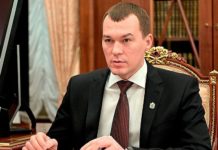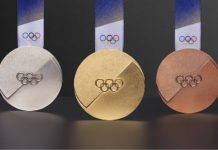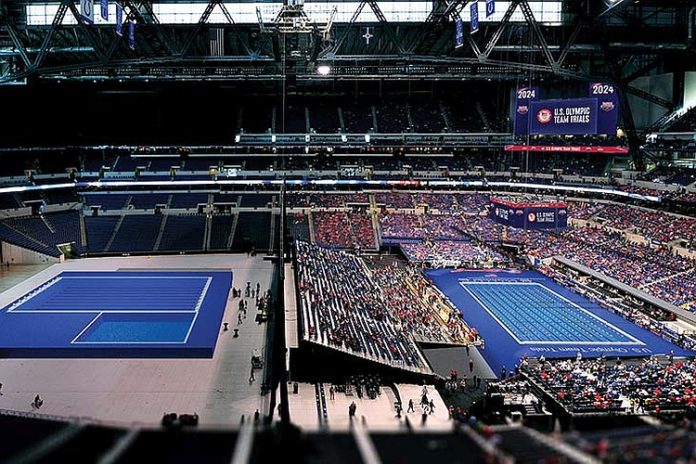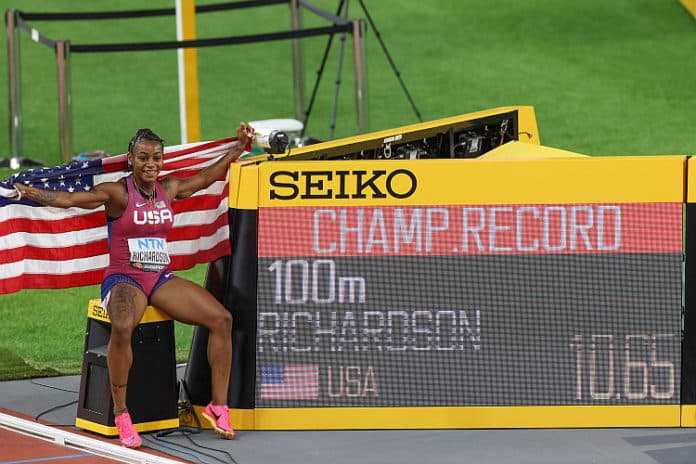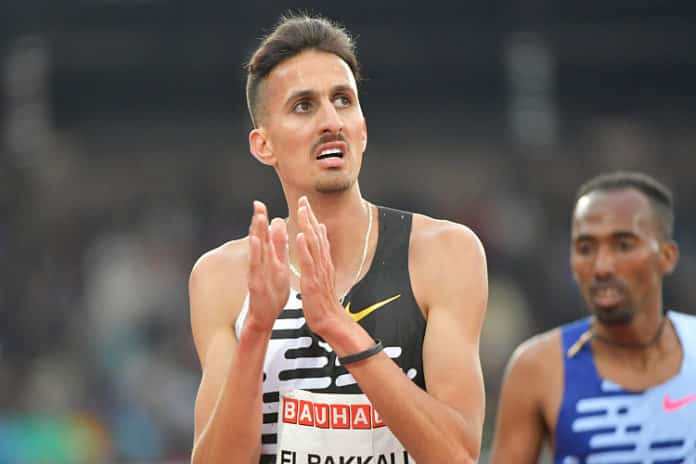★ The Sports Examiner: Chronicling the key competitive, economic and political forces shaping elite sport and the Olympic Movement.★
★ Thank you! Our 32 donors have covered 73% of our summer fund-raising goal. We need you, too! ★
★ To get The Sports Examiner by e-mail: sign up here! ★
≡ THE 5-RING CIRCUS ≡
1. World Athletics research confirms FIFA dominance
2. Spain dominates awards, huge Women’s World Cup TV audiences
3. Paris 2024 declares test-event success for triathlon, archery
4. How are ticket sales going for the 2024 U.S. Swimming Trials?
5. Russia rips World Athletics’ top World Champs moments list
● FIFA grabs the most attention in international sports, as shown by new research done by World Athletics to determine its own “share of voice.” In both 2021 – an Olympic year – and 2022 – a Winter Games and FIFA World Cup year – FIFA is way ahead of the International Olympic Committee and everyone else.
● Women’s World Cup champ Spain dominated the tournament’s awards, as total attendance set a record at almost two million (against a hoped-for 1.5 million total). And the television audience for the final were enormous in Britain, Spain and in Australia.
● The Paris 2024 organizers were positive about the just-completed triathlon and archery test events, despite two of the four triathlon events did not allow swimming in the Seine River. But as part of a massive effort to upgrade the Seine’s safety, organizers and authorities expect no trouble next year.
● Ticket sales for the 2024 USA Swimming Olympic Trials are off to a modest start, with the vast majority of tickets unsold. But the revenue possibilities inherent in placing the event in the Lucas Oil Stadium in Indianapolis, with a possible 30,000 spectators, make it worth the gamble.
● World Athletics created a fan-voted list of the 40 top moments in the 40-year history of its World Athletics Championships. But it had no Russian athletes on it, so of course it was criticized by an important member of the State Duma (legislature), who blamed World Athletics officials and not the fans who voted!
● Panorama: Russia (2: Lysenko says Russian track & field likely out for Paris; stadium honoring Isinbayeva renamed after military service controversy) = Wrestling (remember this name: Amit Elor!) ●
● TSX has special coverage of the World Athletics Championships in Budapest; Monday’s coverage is here ●
1.
World Athletics research confirms FIFA dominance
The worldwide rise of football, powered by not just the club game, but by compelling national-team tournaments such as the FIFA World Cup, Women’s World Cup and European Championships, has overshadowed all other international sports, including the Olympic Games.
Confirmation comes from the newly-released World Athletics Annual Report for 2022, which includes a fascinating chart on its communications highlights page, called “Share of Voice and Tonality.”
Although not specifically labeled, this is undoubtedly compiled by Nielsen, which has been working with World Athletics on data analysis for future direction. The “share of voice” results for 2022 and 2021 show FIFA’s unmistakable leadership position:
2021:
● 61%: FIFA (football)
● 23%: IOC (Olympics)
● 4%: World Athletics
● 3%: World Rugby
● 2%: 5 tied, including UCI (cycling), FIBA (basketball), ITF (tennis), FINA (aquatics) and FIVB (volleyball).
2022:
● 69.60%: FIFA (football)
● 14.57%: IOC (Olympics)
● 4.69%: World Athletics
● 2.41%: ITF (tennis)
● 2.16%: 2 tied, including UCI (cycling) and FIBA (basketball).
These figures are even more astonishing, considering that 2021 was an Olympic year, with no major FIFA tournament. The FIFA share rose by more than 14% in 2022, with the FIFA World Cup in November and December, but the IOC fell way back, despite having a compelling Winter Games in Beijing in February of 2022.
The World Athletics share moved from 4% to 4.69%, a worthwhile increase, and well ahead of the top “tier one” sports at the Olympic Games: World Aquatics (1.33%) and the Federation Internationale de Gymnastique (0.42%). In fact, FIG is almost invisible, at 1% for 2021 and much less in 2022.
For 2023, one would expect – if World Athletics posts these figures next year – that FIFA would be well in front again after the strong interest in the Women’s World Cup in Australia and New Zealand.
Perhaps FIFA chief Gianni Infantino (SUI) should send World Athletics President Sebastian Coe (GBR) a thank-you gift?
2.
Spain dominates awards; huge Women’s World Cup TV audiences
For a team which was in revolt in September 2022, when 15 players sent simultaneous messages to the national federation asking NOT to be called to the national team over facilities, support and the decision of coach Jorge Vilda, Spain engineered a brilliant triumph at the 2023 FIFA Women’s World Cup.
Of the 15 players who sent these messages, eight finally agreed to selection if called, after discussions produced several changes in the way the women’s team was run. Of the eight, three eventually made the team: midfielder Aitana Bonmati, forward Mariona Caldentey, and defender Ona Batlle.
Caldentey set up Olga Carmona’s 29th-minute winning goal in the final, and Bonmati was named the winner of the Golden Ball as the top player in the tournament. Teammate Jennifer Hermoso was second (Silver Ball) and Swedish defender Amanda Ilestedt (Bronze Ball).
The top scorers were honored with the Golden Boot, for Japan’s Hinata Miyazawa (five goals and one assist); the Silver Boot to France’s Kadidiatou Diani (4 + 3) and Germany’s Alexandra Popp (Bronze Boot: 4 + 0).
The top keeper was England’s Mary Earps, who kept the Lionesses in the final until the end.
Spain’s electric striker Salma Paralluelo, who had two goals at age 19, was named “Best Young Player” and Japan won the Fair Play Award.
¶
The biggest winner was women’s football, with interest in the 2023 FIFA Women’s World Cup far surpassing any of the eight tournaments that came before.
With sell-outs for the semifinals, third-place and championship match, attendance finished at 1,978,274, smashing the old mark from Canada in 2015 of 1,353,506 (played with fewer matches). On a per-game average basis, the 2023 Women’s World Cup was the third to surpass average attendance of 30,000 or more:
● 37,944 in 1999 (hosted in the U.S.: 32 matches)
● 37,218 in 2007 (China: 32)
● 30,911 in 2023 (Australia and New Zealand: 64)
● 26,428 in 2011 (Germany: 32)
● 26,029 in 2015 (Canada: 52)
About 87% of all seats for the 2023 tournament were sold; FIFA was targeting 1.5 million attendees and far surpassed that. About 770,000 visited the various fan festivals held in the host cities. Even the volunteer staff was excited, with a reported attendance rate of 95%.
Television audiences were also big, with Reuters reporting that a total of 14.46 million viewers – peak viewers – watched the final in Britain, with 12.0 million on the BBC and 2.46 million on the concurrent broadcast on ITV. That’s the second-largest audience of 2023; only the coronation of King Charles III was bigger.
In Spain, the average audience was 5.6 million on public broadcaster RTVE, with a peak of 7.4 million. The match had an audience share of 65.7%, meaning that of all televisions in the country that were on during the game, almost two-in-three were watching the match, with a peak at 71.1%. That’s the most for any women’s football match ever in Spain.
Australian viewing of the championship match was 5.54 million at peak, well down from the peak of 11.15 million (average audience 7.2 million) on Channel Seven for the Australia-England semifinal.
3.
Paris 2024 declares test-event success for triathlon, archery
True, the water quality in the Seine River in Paris was insufficient for the final two days of last week’s triathlon test event, but the Paris 2024 organizers were pleased nonetheless, promoting the effort as a success:
“Over the last few days, and a year ahead of schedule, the heart of the French capital has been beating to the rhythm of the Paris 2024 Games. Test events took place simultaneously for triathlon and Para triathlon in an area around the Pont Alexandre III and, in the immediate vicinity, for archery and Para archery on the Esplanade des Invalides. The events proved to be great learning opportunities that proved the key concepts behind Paris 2024 and allow all to look ahead to the Games with heightened anticipation and confidence. …
“Although this last competition – like yesterday’s Para triathlon events – was run as a duathlon (running – cycling – running), due to discrepancies in the results of water quality analysis of the Seine, the Test Event proved positive generally.”
The announcement was 90% about the triathlon and especially the water quality of the Seine, for which public swimming has been banned since 1923. The women’s and men’s Olympic-distance triathlon events held last Thursday and Friday were held with swimming in the river, but not on Saturday for the Para events, or Sunday for the Mixed Relay:
“Even though the swimming events were not able to be held during the last two days of competition (as a precautionary measure for the health of the triathletes and Para triathletes), the ongoing work on wastewater management and the delivery of new infrastructure for the treatment of rainwater between now and the Olympic Games Paris 2024, will mean that the water quality will be improved and, as a result, the events will be held as planned.
“New infrastructure will include the Austerlitz reservoir, an enormous storage basin 50m in diameter and more than 30m deep will allow for the storage of more than 50,000m3 of water, equivalent to 20 Olympic pools. This reservoir will allow event organisers to be better prepared for exceptional weather events by preventing wastewater from being discharged into the Seine in the event of heavy rain.”
Rain and the pollution brought by it led to the cancellation of the open-water swimming test event in early August.
The archery competition went off well and there was some coordination between the two, on people flows and security.
There are many more test events to come, with Mountain Bike cycling next on 24 September. But the Seine, site of the Opening Ceremony, and then open-water swimming and triathlon, is emerging more and more as the centerpiece of the host city’s preparations to change Paris in 2024.
4.
How are ticket sales going for the 2024 U.S. Swimming Trials?
One of the highlights on the road to Paris in 2024 should be the U.S. Olympic Trials in swimming, slated to be held before 30,000-plus spectators in Lucas Oil Stadium in Indianapolis, Indiana.
The sport’s Olympic Trials sold out in its prior three editions at the CHI Health Center in Omaha, Nebraska, with about 18,000 in seating for each session. But the sales have gotten off to a slow start for 2024.
SwimSwam.com reported that an unofficial count based on the Ticketmaster seating charts showed 23,199 tickets available for the first three-day package; the meet is nine days and all-session and three-day packages are available. Editor Braden Keith estimated that the unsold inventory for the first three days is $8.16 million, or more than $24 million for the meet in total.
He notes that USA Swimming reported $5.5 million in revenue from all of its 2016 meets (including the Trials in Omaha), so the opportunity to make some real money even at less-than-full capacity is substantial. And that’s why the meet is being held in an NFL stadium.
A follow-up story on Monday noted some blowback about the ticket pricing, which is normal when there are increases. Keith suggested a way to sell some of the weakest tickets might be to use them as a fund-raiser for local clubs, but for most folks, Paris 2024 is still pretty far away.
And the prices in Indianapolis are a far cry from the costs of attending the Olympic Games in Paris, including tickets, travel and accommodations.
It’s early yet.
5.
Russia rips World Athletics’ top World Champs moments list
In commemoration of the 40-year anniversary of the first World Championships in Helsinki (FIN) in 1983, World Athletics created a fan-voted project to name the top 40 moments in Worlds history.
Announced between 30 June and 19 July, the list included athletes from 20 countries. But none from Russia.
So, Dmitry Svishchev, the head of the State Duma Committee on Physical Culture, Sport and Youth Policy, complained, clearly without knowing how it was compiled:
“I think that the [World Athletics President Sebastian] Coe and the veterans who lead the federation and determine this list on a national basis should carefully study the history of athletics, open the ratings of competitions, encyclopedias. We’re not talking about lists of the strongest athletes only in the UK or the USA, are we? By what criteria were certain athletes chosen to enter there? I doubt that there is a national sign there.
“Or write then – ‘the most influential, with the exception of Russians’ – otherwise, this list says nothing. Our athletes are among the most titled in the world, I’m not talking about the athletes of the USSR. If I were [World Athletics], I would be outraged by this behavior. Still, apparently, there is some kind of conflict between our and the world federation.”
Yuriy Borzakovskiy, the 2004 Olympic men’s 800 m winner, told TASS:
“The absence of Russian women in the list of the 40 strongest track and field athletes of the World Championships, who have made the greatest contribution to the development of our sport, is surprising to me.
“I do not belittle the merits of all the athletes on the list, but I believe that Yelena Isinbayeva [pole vault] and Maria Lasitskene [high jump], who have won three gold medals at the World Championships, which no one else has managed to do in their disciplines, deserve to be recognized by the international federation no less.”
World Athletics had some fun with fans, but it looks like some folks didn’t read the rules. Can’t win.
≡ PANORAMA ≡
● Russia ● Russian high jump star Danil Lysenko found himself in agreement Saturday with comments by World Athletics chief Sebastian Coe last Thursday, that Russian participation at the Paris 2024 Olympic Games is “unlikely.” Lysenko, the 2018 World Indoor Champion and no. 2 on the 2023 world list at 2.35 m (7-8 1/2) told the Russian news agency TASS:
“In principle, I don’t even expect that we will be allowed to the Olympics, I’m set on other goals. I’m very glad that we have major competitions planned, including the [2024] BRICS Games and the Friendship Games. I hope that everything will work out.”
¶
A stadium in the Dagestan region has been renamed as the “Trud Stadium,” removing the name of two-time Olympic women’s vault champion Isinbayeva.
Isinbayeva was cleared by the International Olympic Committee to continue as a member, with its Ethics Commission determining that she has not supported the Russian invasion of Ukraine. In this context, Isinbayeva, 41, said her military involvement is “nominal,” despite having had the rank of Major – possibly in an honorary capacity – in the Russian Army.
The comment got her into trouble with hard-liners, and the Dagestan Republic decided to change the stadium name.
● Wrestling ● Another name to remember for 2024: Amit Elor, of Walnut Creek, California.
Elor won the World Cadet and World U-20 titles at age 17 in 2021 at 69 kg, then won a sensational triple in 2022, taking the World U-20 Championship at 72 kg, the World U-23 title and the World Championships gold.
And she’s at it again – still just 19 – winning her third straight World U-20 belt at 72 kg in Amman (JOR), taking her bouts by a 10-0 technical fall, a pinfall in 1:40 and technical falls of 10-0 and 11-0. That’s 31-0 and a pin. Remember the name.
¶
You can receive our exclusive TSX Report by e-mail by clicking here. You can also refer a friend by clicking here, and can donate here to keep this site going.
For our updated, 787-event International Sports Calendar (no. 3) for 2023 and beyond, by date and by sport, click here!
















